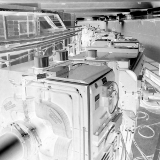Speaker
Christian Smorra
(CERN)
Description
CPT symmetry in the Standard Model reflects the equivalence of antiparticles and their matter conjugates in the fundamental interactions, excluding gravity. It predicts that such conjugate pairs have identical masses, lifetimes, charges and magnetic moments, the latter two of opposite sign.
Single antiprotons confined and thermalized in a cryogenic Penning-trap system allow performing high-precision measurements of the fundamental properties of the antiproton. Its magnetic moment is determined from measuring the ratio of the spin-precession frequency to the cyclotron frequency. For this purpose, the continuous Stern-Gerlach effect is applied, which allows to perform spectroscopy of the spin-precession frequency by non-destructive detection of the antiproton’s spin state, whereas the cyclotron frequency is measured by image current detection. Using these methods in the double Penning-trap measurement scheme, we recently achieved the today’s most precise measurement of the proton magnetic moment with 3.3 ppb uncertainty [1]. Applying the same method to the antiproton will yield a thousand-fold improved test of CPT invariance in the baryon sector.
In addition, we are planning to improve the 90 ppt uncertainty in proton/antiproton charge-to-mass ratio measurements by comparing the cyclotron frequencies of the proton modelled by an H- ion and the antiproton. By using newly developed fast particle exchange techniques and phase-sensitive detection methods, we target an improvement by at least one order of magnitude. Assuming that CPT invariance holds, this measurement can be interpreted as a test of the weak equivalence principle by the gravitational redshift.
In this talk, I will review the proton measurement and present the status of the antiproton trap system BASE, Baryon Antibaryon Symmetry Experiment, which was commissioned at CERN’s antiproton decelerator and the results from its first antiproton physics run in 2014.
[1] A. Mooser et al., Nature 509, 596 (2014).
Author
Christian Smorra
(CERN)
Co-authors
Andreas Hannes Mooser
(RIKEN (JP))
Georg Ludwig Schneider
(Johannes-Gutenberg-Universitaet Mainz (DE))
Hiroki Nagahama
(University of Tokyo (JP))
Jochen Walz
(Johannes-Gutenberg Universität Mainz)
Klaus Blaum
(Max-Planck-Gesellschaft (DE))
Kurt Alan Franke
(Max-Planck-Gesellschaft (DE))
Simon Van Gorp
(Inst. of Physical and Chemical Research (JP))
Stefan Ulmer
(RIKEN (JP))
Takashi Higuchi
(University of Tokyo (JP))
Wolfgang Quint
(GSI Helmholtzzentrum für Schwerionenforschung)
Yasunori Yamazaki
(RIKEN)
Yasuyuki Matsuda
(University of Tokyo (JP))
